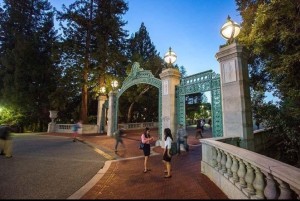UC Berkeley also began offering indoor classes this week. Classes will be capped at 26 students, with all students required to test weekly for COVID, complete a daily symptom screening and wear a mask. Outdoor classes have been conducted within the College of Natural Resources and the engineering department.
COVID Vaccinations Not Required for UC Students This Fall
Barring a sudden change in the national situation, the University of California and CSU campuses are preparing for students, staff and faculty to return to campus this fall for in-person instruction. While there are no plans to require COVID vaccinations, various vaccination sites have already been implemented on some campuses should a student wish a vaccination.
In addition to the current zoom classroom scenario, a few UC campuses have also cautiously been exploring in-person instruction this academic year. Approximately 2,200 students at UCSD are taking classes in 50-person tents equipped with wifi, weatherproof speakers, podcasting equipment, whiteboards and display screens. The university began experimenting with in-person pandemic learning last fall, when 10% of its courses were offered face-to-face. Standard protocols are in place including mandatory face masks and seating that is spaced at least six feet apart. Thus far there is no evidence of COVID transmission and the administration plans to add additional indoor instruction later this spring, with each class restricted to either 25% capacity or 50 students, whichever is smaller.
To read more about the vaccination roll-out and how it affects students, click here.

Planning for fall
But most California colleges, including the UC and CSU systems overall, are focused on Fall 2021 as the date for a return to campus life. Dr. Anthony Fauci, the nation’s top infectious disease expert, sparked optimism among higher education leaders in December when he predicted that most college students could be vaccinated by late summer. Bringing students back to campus is important for not just colleges’ culture and learning environments, but also their bottom lines; many have lost millions of dollars in revenue as students stopped paying for dorms and meal plans.
“We all want to get back to normal, knowing that normal is not what it was before, but we’re working really hard to bring back our students and to have that on campus interaction,” said Kristen Soares, president of the Association of Independent California Colleges and Universities, which represents private colleges.
Some students say they’re cautious about returning. Alissa Vasquez had been looking forward to transferring to Cal State Northridge from community college this fall, and reuniting with friends there. But if her campus doesn’t require students to be vaccinated, Vasquez said, she worries that she’ll endanger her immunocompromised grandmother by commuting from her family home to in-person classes.
“As much as I’d love to have that college experience and see the university firsthand, I just still don’t feel safe,” Vasquez said.
When UC student leaders met with President Michael Drake to discuss the university’s return to in-person learning, they urged him to give students flexibility, said UC Santa Cruz student body president Shivika Sivakumar.
“We are really pushing for a hybrid option because we know not everyone would be vaccinated by then,” Sivakumar said. “Most of our talk with President Drake was, ‘When you come up with a plan of action, make sure you’re keeping in mind that there are different student groups and different staff professionals who are going through different things right now. If you make remote not an option anymore, it’s going to be hard.’ ”
Faculty, too, are pushing to have a voice in universities’ fall plans.
Schademan, the Chico State science education professor, said administrators there did not consult with instructors before deciding that 20 to 30% of fall classes would be in-person. As he weighs returning to the classroom, he said a lot of questions remain unanswered — such as whether he’ll have access to the sinks and supplies he needs to effectively train new science teachers.
“If you don’t get input from the people who are going to be in the classrooms actually doing the teaching, then whatever plan you come up with is not going to work,” said Schademan, who is also the faculty rights chair for the Chico State chapter of the California Faculty Association.
Even after more students and employees are vaccinated, colleges shouldn’t expect a return to the carefree days of 2019, said Gerri Taylor, co-chair of the American College Health Association’s COVID-19 task force.
Students will still need to wear masks, be tested for the virus regularly — her organization recommends at least once upon arrival to campus and twice a week after that — quarantine if exposed and socially distance within the classroom, she said.
And new variants could prompt a need to create new vaccines that students in coming years will have to receive, she said. “It may become a yearly occurrence, just like the flu vaccine.”



This Post Has 0 Comments